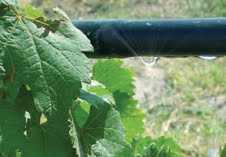Drip Irrigation systems and water conservation: alternatives and technological innovations
Drip irrigation systems have been widely used as low water consumption systems for irrigation purposes. But which are the trends in 2013?
By Tobias Mendelovici, Agronomist of Hebrew University of Jerusalem and Ocean Business Director.This article was translated from its original version in Spanish.
Drip irrigation systems allow accurate amounts of water application without waste but also allow the integrated use of fertilizers through them. These systems were invented by engineers and farmers in Israel several decades ago. Harsh conditions of an arid territory made these systems were developed as they make more efficient use of natural resources. In fact, over 80% of irrigated areas in Israel use drip irrigation and micro irrigation.
- Compared with gravity irrigation systems or grooves the water savings in drip irrigation systems ranges by 50-70% and compared with sprinkler systems they have 20% savings.
During my agronomy studies at Hebrew University of Jerusalem for almost 25 years, I remember how water with high salinity levels was used in experimental fields and tolerant crops like tomatoes, melons, asparagus, grapes and olives were drip irrigated. In fact, these systems allow the use of waters with higher salinity levels for irrigation. And since then there have been many advancements.
New technological developments in Israel have allowed introducing the first generation of drippers: auto compensated or compensated drippers as well as high speed production lines for cylindrical and flat drippers.
Drippers are unique in the market since they are designed especially for areas with varied topography, scarce and poor quality water resources which make them suitable for uneven terrain, as well as with sewage and recycled waters.
In contrast with super smart and efficient drip irrigation systems there are irrigation systems called TAPE which are a cheaper competitor and consists of a plastic tube with holes through which water goes out. This product cannot provide special functions that provide drippers, such as cleaning water or high pressure change when water enters to the system and change to zero pressure that allow water to drip out. Furthermore, TAPE tubes do not guarantee that water discharge is heterogeneous through lower tube which is critical for some crops, while for others such as cotton and potatoes it is not as important.
And after describing today and future trends, I end up this article with an interesting story from the distant past of drip irrigation: In one of the field trips I made in Southern Israel near to Ben Gurion University experimental station to a plot that was cultivated 2,000 years ago by ancient farmers of the desert: the Nabataeans . Their agricultural methods were extremely sophisticated. They built terraces and cleaned rocks in the floor and so they managed that every water drop from the rains were collected and directed to the fields by gravity.
- Today, 2000 years later there are still irrigation systems for gravitational dripping which are ideal for small plots of lands since they are very simple for installing, operating and maintaining. No infrastructure and no electricity are needed. These systems are compatible with displayable tanks that store rainwater (see http://oceanbusiness.com.es/captacion-del-agua-de-lluvias/)
- Visit the following link for more information about Israeli international recognition in this topic http://oceanbusiness.com.es/reconocen-a-israel-como-lider-mundial-en-la-provision-de-tecnologias-de-riego-y-agua/
Photos: Metzer’s Courtesy



